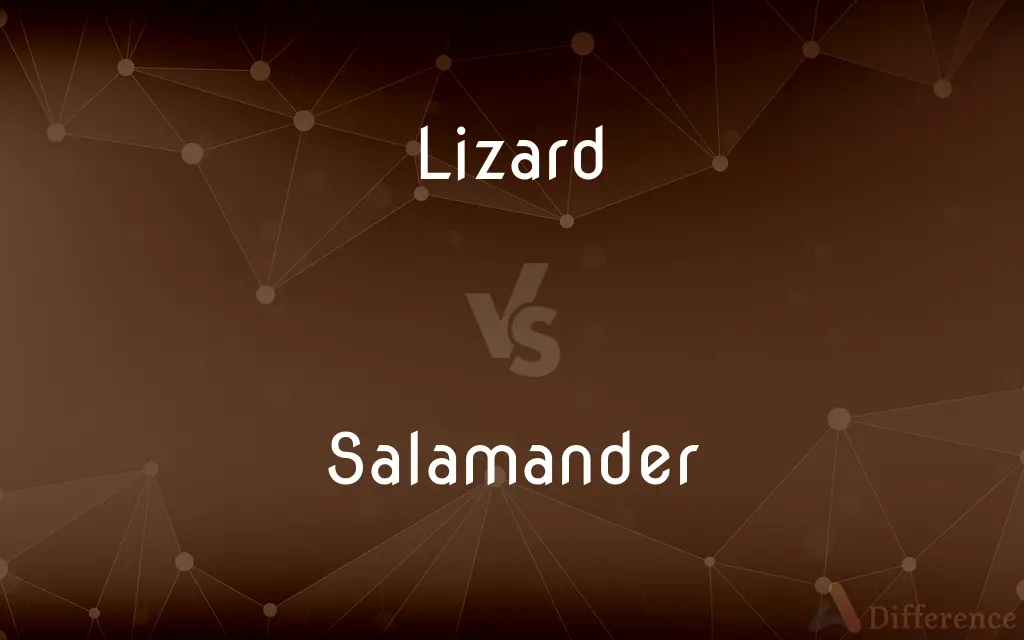Lizard vs. Salamander — What's the Difference?
Edited by Tayyaba Rehman — By Fiza Rafique — Updated on October 27, 2023
Lizards are reptiles with scaly skin and external ear openings; salamanders are amphibians with moist, smooth skin and no external ears.

Difference Between Lizard and Salamander
Table of Contents
ADVERTISEMENT
Key Differences
Lizards are reptiles that belong to the order Squamata. They are characterized by their scaly skin, external ear openings, and typically lay eggs, although some give birth to live young. Salamanders, in contrast, are amphibians belonging to the order Caudata. They have moist, smooth skin and are usually found in damp environments.
Salamanders are known for their ability to regenerate lost limbs, a trait not shared by lizards. While some lizards can regenerate their tails, salamanders can regrow entire limbs and other body parts. Lizards, on the other hand, are more diverse in size and habitat, with some species adapted to arid environments, unlike most salamanders.
Most lizards are oviparous, laying eggs that hatch outside the mother's body. In contrast, some salamanders exhibit viviparity, giving birth to live young. Lizards generally have well-developed vision, while salamanders rely more on their sense of smell and touch due to their often dim or aquatic habitats.
In terms of behavior, many lizards are diurnal, active during the day, while salamanders are often nocturnal or crepuscular, active during twilight or night. Lizards have a wide range of diets, from insectivorous to herbivorous, whereas salamanders primarily feed on small invertebrates.
Finally, lizards are found in a wide range of environments, from deserts to forests, while salamanders are more restricted to moist or aquatic habitats. This reflects their respective adaptations as reptiles and amphibians.
ADVERTISEMENT
Comparison Chart
Class
Reptilia (Reptiles)
Amphibia (Amphibians)
Skin
Scaly, dry
Moist, smooth
Ear Openings
External ear openings
No external ears
Regeneration
Limited, usually tails only
Can regenerate limbs, tail, and other parts
Reproduction
Mostly oviparous (egg-laying)
Both oviparous and viviparous (live-bearing)
Habitat Diversity
Wide range, including arid environments
Primarily moist or aquatic habitats
Compare with Definitions
Lizard
"The gecko is a small lizard that can climb walls."
Salamander
"In alchemy, the salamander symbolizes fire and transformation."
Lizard
"He's a lizard, always basking in the sun."
Salamander
"She's a salamander, thriving in difficult environments."
Lizard
"In some cultures, the lizard represents regeneration."
Salamander
"I found a spotted salamander under a log in the forest."
Lizard
"My friend has a bearded dragon lizard as a pet."
Salamander
Salamanders are a group of amphibians typically characterized by a lizard-like appearance, with slender bodies, blunt snouts, short limbs projecting at right angles to the body, and the presence of a tail in both larvae and adults. All 10 present-day salamander families are grouped together under the order Urodela.
Lizard
"He's a cold-blooded lizard in business, very ruthless."
Salamander
Any of various small, tailed amphibians of the order Caudata, having porous scaleless skin and usually two pairs of limbs of equal size, found chiefly in northern temperate regions.
Lizard
Lizards are a widespread group of squamate reptiles, with over 6,000 species, ranging across all continents except Antarctica, as well as most oceanic island chains. The group is paraphyletic as it excludes the snakes and Amphisbaenia; some lizards are more closely related to these two excluded groups than they are to other lizards.
Salamander
A mythical creature, generally resembling a lizard, believed capable of living in or withstanding fire.
Lizard
Any of numerous squamate reptiles often classified in the suborder Lacertilia, characteristically having a scaly elongated body with a tapering tail, four legs, movable eyelids, and external ear openings.
Salamander
In the occult philosophy of Paracelsus, a being having fire as its element.
Lizard
Leather made from the skin of one of these reptiles.
Salamander
An object, such as a poker, used in fire or capable of withstanding heat.
Lizard
Any reptile of the order Squamata that is not a snake or an amphisbaenian, usually having four legs, external ear openings, movable eyelids and a long slender body and tail.
Salamander
(Metallurgy) A mass of solidified material, largely metallic, left in a blast-furnace hearth.
Lizard
Lizard skin, the skin of these reptiles.
Salamander
A portable stove used to heat or dry buildings under construction.
Lizard
(colloquial) An unctuous person.
Salamander
A long, slender, chiefly terrestrial amphibian of the order Caudata, superficially resembling a lizard.
Lizard
(colloquial) A coward.
Salamander
(mythology) A creature much like a lizard that is resistant to and lives in fire (in which it is often depicted in heraldry), hence the elemental being of fire.
Lizard
(rock paper scissors) A hand forming a "D" shape with the tips of the thumb and index finger touching (a handshape resembling a lizard), that beats paper and Spock and loses to rock and scissors in rock-paper-scissors-lizard-Spock.
Salamander
(cooking) A metal utensil with a flat head which is heated and put over a dish to brown the top.
Lizard
(in compounds) A person who idly spends time in a specified place, especially a promiscuous female.
Lounge lizard; lot lizard; beach lizard; truck stop lizard
Salamander
(cooking) A small broiler (North America) or grill (Britain) that heats the food from above, used in professional cookery primarily for browning.
The chef first put the steak under the salamander to sear the outside.
Lizard
Any one of the numerous species of reptiles belonging to the order Lacertilia; sometimes, also applied to reptiles of other orders, as the Hatteria.
Salamander
The pouched gopher, Geomys tuza, of the southern United States.
Lizard
A piece of rope with thimble or block spliced into one or both of the ends.
Salamander
A large poker.
Lizard
A piece of timber with a forked end, used in dragging a heavy stone, a log, or the like, from a field.
Salamander
(metallurgy) Solidified material in a furnace hearth.
Lizard
Relatively long-bodied reptile with usually two pairs of legs and a tapering tail
Salamander
(construction) A portable stove used to heat or dry buildings under construction.
Lizard
A man who idles about in the lounges of hotels and bars in search of women who would support him
Salamander
A fire-eater performer who pretends to swallow fire.
Salamander
To use a salamander (cooking utensil) in a cooking process.
Salamander
Any one of numerous species of Urodela, belonging to Salamandra, Amblystoma, Plethodon, and various allied genera, especially those that are more or less terrestrial in their habits.
I have maintained that salamander of yours with fire any time this two and thirty years.
Whereas it is commonly said that a salamander extinguisheth fire, we have found by experience that on hot coals, it dieth immediately.
Salamander
The pouched gopher (Geomys tuza) of the Southern United States.
Salamander
A culinary utensil of metal with a plate or disk which is heated, and held over pastry, etc., to brown it.
Salamander
A large poker.
Salamander
Solidified material in a furnace hearth.
Salamander
Any of various typically terrestrial amphibians that resemble lizards and that return to water only to breed
Salamander
Reptilian creature supposed to live in fire
Salamander
Fire iron consisting of a metal rod with a handle; used to stir a fire
Salamander
"The salamander in folklore is often associated with fire."
Salamander
"The salamander plays a curious role in many fantasy novels."
Common Curiosities
Can salamanders regenerate their tails?
Yes, salamanders can regenerate tails and even limbs.
Can lizards live in water?
Some lizards are semi-aquatic, but they are primarily land animals.
Are all lizards cold-blooded?
Yes, all lizards are ectothermic, relying on the environment for warmth.
Do lizards have good hearing?
Most lizards have well-developed hearing due to external ear openings.
Are salamanders poisonous?
Some salamander species have toxic skin secretions.
Are lizards and salamanders related?
They are different; lizards are reptiles and salamanders are amphibians.
Can salamanders breathe underwater?
Some can, while others use their skin or lungs for respiration.
Do salamanders have scales?
No, salamanders have smooth, moist skin without scales.
How do lizards regulate their body temperature?
Lizards bask in the sun or seek shade to regulate their temperature.
How long do salamanders live?
Lifespan varies, but some can live over 20 years.
Can lizards regrow limbs?
No, lizards can't regrow limbs, only their tails in some cases.
Do all lizards lay eggs?
Most do, but some give birth to live young.
Are salamanders active during the day?
Most are nocturnal or crepuscular, active during twilight or night.
Do salamanders make good pets?
Some species can be kept as pets, but they require specific care and habitat.
What do lizards eat?
Lizards have varied diets, from insects to plants, depending on the species.
Share Your Discovery

Previous Comparison
Cinerarium vs. Columbarium
Next Comparison
Latitude vs. LongitudeAuthor Spotlight
Written by
Fiza RafiqueFiza Rafique is a skilled content writer at AskDifference.com, where she meticulously refines and enhances written pieces. Drawing from her vast editorial expertise, Fiza ensures clarity, accuracy, and precision in every article. Passionate about language, she continually seeks to elevate the quality of content for readers worldwide.
Edited by
Tayyaba RehmanTayyaba Rehman is a distinguished writer, currently serving as a primary contributor to askdifference.com. As a researcher in semantics and etymology, Tayyaba's passion for the complexity of languages and their distinctions has found a perfect home on the platform. Tayyaba delves into the intricacies of language, distinguishing between commonly confused words and phrases, thereby providing clarity for readers worldwide.














































